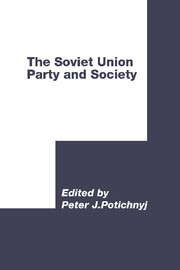Book contents
- Frontmatter
- Contents
- List of figures
- List of tables
- List of contributors
- Foreword by R. C. Elwood
- Preface by P. J. Potichnyj
- Part 1 Party apparat
- Part 2 Socialization and political discourse
- Part 3 Social policy
- 9 Social deprivation under Soviet full employment
- 10 The Soviet social security system: its legal structure and fair hearings process
- 11 Abortion in the Soviet Union: why it is so widely practiced
- 12 Ethnic group divided: social stratification and nationality policy in the Soviet Union
- 13 The party and Russian nationalism in the USSR: from Brezhnev to Gorbachev
- Index
- Publications from the Third World Congress for Soviet and East European Studies
12 - Ethnic group divided: social stratification and nationality policy in the Soviet Union
from Part 3 - Social policy
Published online by Cambridge University Press: 04 August 2010
- Frontmatter
- Contents
- List of figures
- List of tables
- List of contributors
- Foreword by R. C. Elwood
- Preface by P. J. Potichnyj
- Part 1 Party apparat
- Part 2 Socialization and political discourse
- Part 3 Social policy
- 9 Social deprivation under Soviet full employment
- 10 The Soviet social security system: its legal structure and fair hearings process
- 11 Abortion in the Soviet Union: why it is so widely practiced
- 12 Ethnic group divided: social stratification and nationality policy in the Soviet Union
- 13 The party and Russian nationalism in the USSR: from Brezhnev to Gorbachev
- Index
- Publications from the Third World Congress for Soviet and East European Studies
Summary
Any analysis of ethnic relations in the Soviet Union requires combining two grand theories: a theory of ethnicity and ethno-nationalism in industrial society and a theory of Soviet society as one of two types of existing industrial societies. Such synthesis is beyond the scope of this chapter, but I will at least outline several premises which presuppose my understanding of these two phenomena and which underlie the argument developed here.
There is solid empirical evidence to support the claim that the rise of nationalism, the process of modernization and social mobilization are correlated. As Ernest Gellner has put it, any modern state requires “a mobile, literate, culturally standardized, interchangeable population.” Correspondingly, the process of modernization imposes a standardized, homogeneous, centrally sustained culture on all minority groups in a multi-ethnic state. Some of them might resist for various reasons; and under certain conditions this objective need for homogeneity might provoke in these minorities a nationalistic response. This argument, as Arthur Waldron points out, reverses the commonly accepted causality and contradicts the widely held “belief that nationalism comes first, and then nationalist struggle.” The argument emphasizes the role of nationalism in conflict, where nationalism serves as a weapon in the struggle for self-determination or internal competition. “Ethnic groups are born and rise because of the perception of oppression,” writes Dov Ronen; “if there were no perception of oppression, real or imagined, there would be no ethnic self-determination.”
- Type
- Chapter
- Information
- The Soviet Union: Party and Society , pp. 218 - 228Publisher: Cambridge University PressPrint publication year: 1988



